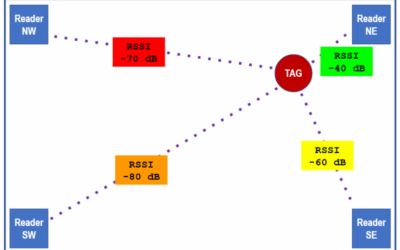What is RTLS?
Real Time Location Systems (RTLS) is a solution which uses technology to automatically identify and track the location of people or objects in real time, usually within a defined, contained area. RTLS is a broad term; RTLS solutions can utilize a range of wireless technologies, including RFID tags, Bluetooth Beacons, Wireless Local Area Network (WLAN, WiFi), Smart Devices, and more.
What are the components of an RTLS system?
A Real Time Location System (RTLS) typically include transponders, a receiver, and a software program. The transponder has a unique code or ID number, which is used to identify an individual person or object. The transponder sends this signal (unique ID) to receivers placed at specific locations in the designated area. Similar to the transponder’s unique ID identifying the person or object, each receiver uniquely identifies its location. When the receiver picks up a signal from the transponder, it sends this data to the software program. The software interprets this information and combines the unique ID, the location of the reader, and the date/time the signal was recorded. The general value of the real-time location system (RTLS) lies in the ability to time-stamp the location of a unique ID as that unique ID moves within the system’s defined area.
What should I consider when choosing RTLS technology?
The solution or end-goal is the most important factor when choosing the RTLS technology.
- Are you tracking a person or an object?
- How frequently do you need to see the location? Once a day? At all times?
- How accurate does the location data need to be?
Personnel vs. Assets
RTLS for personnel is most frequently implemented as an emergency mustering solution in high-risk workplaces. These systems usually utilize RFID, Bluetooth Low Energy (BLE), WiFi, IoT, technology, or a combination of these.
RTLS is used to track assets in various scenarios; the technology varies based on the solution. Below are a few examples:
- Inventory Management: Instantaneously locate an individual item in a large warehouse
- Shipping: Track the location of assets being shipped, to ensure timeliness of delivery and product integrity
- WIP (Work-in-Progress): Track items during manufacturing, the equipment or tools used during manufacturing, and finished goods in a warehouse / shipping location.
Sometimes RTLS can even be used in conjunction with RFID. In the next section we will discuss how a hospital implemented an innovative RTLS solution using passive RFID.
Hospital Infection Control Management & RTLS
The Problem
The hospital needed an automated RTLS management solution to ensure janitorial staff follow the hospital’s infection protocol when emptying trash bins. The hospital needed an automated, passive solution to ensure:
- Trash bins are emptied at set intervals throughout the day (once every 24 hours)
- Trash bins are emptied individually at the hospital trash room— they cannot be emptied into other trash bins, especially on patient floors
The Solution
The RTLS solution implemented utilized UHF RFID technology.
- Transponders: Each trash can was tagged with a passive UHF RFID tag with a unique ID.
- Receivers: Alien Technology ALR-9650 readers were installed on hospital ceilings and at key chokepoints (doorways and hallways). When the trash can was moved within the hospital, the UHF tag would become energized from the reader, and send back its unique ID. This reader then sent this time-stamped location to the software.
- Software: The software tracked the date-time stamped movement of each trash bin to ensure each bin was emptied at least once every 24 hours. The software also tracked the path of each bin to ensure each bin was emptied in the hospital trash room, and followed the correct path to get there. The progression of each bin’s movement on a specific floor was tracked by the readers installed in the ceiling. The readers at the chokepoints verified the trash can entered a specific room. If either of these conditions were not met, the software would send an automated message to alert management.
The Result
The hospital discovered the janitorial staff was not following the protocol — the trash bins were not always emptied at the correct intervals, partly filled trash bins were being emptied into other partly filled bins, and this was taking place in hallways and patient areas. Needless to say, the hospital learned a great deal about its trash flow by incorporating a cost efficient frictionless RTLS data collection system that automated this aspect of their infection control protocol. With the UHF readers installed in key choke points, additional assets can be added and tracked with similar benefits.
Note: Active RFID & RTLS
RTLS RFID solutions can also be designed with active RFID tags, however, because these are battery powered, the cost of each tag is significantly greater. Oftentimes, similar results can be achieved with passive or active tags, however, passive tags are much more cost effective.
If you’re interested in learning more about an RTLS RFID solution, don’t hesitate to email us at [email protected]!


0 Comments